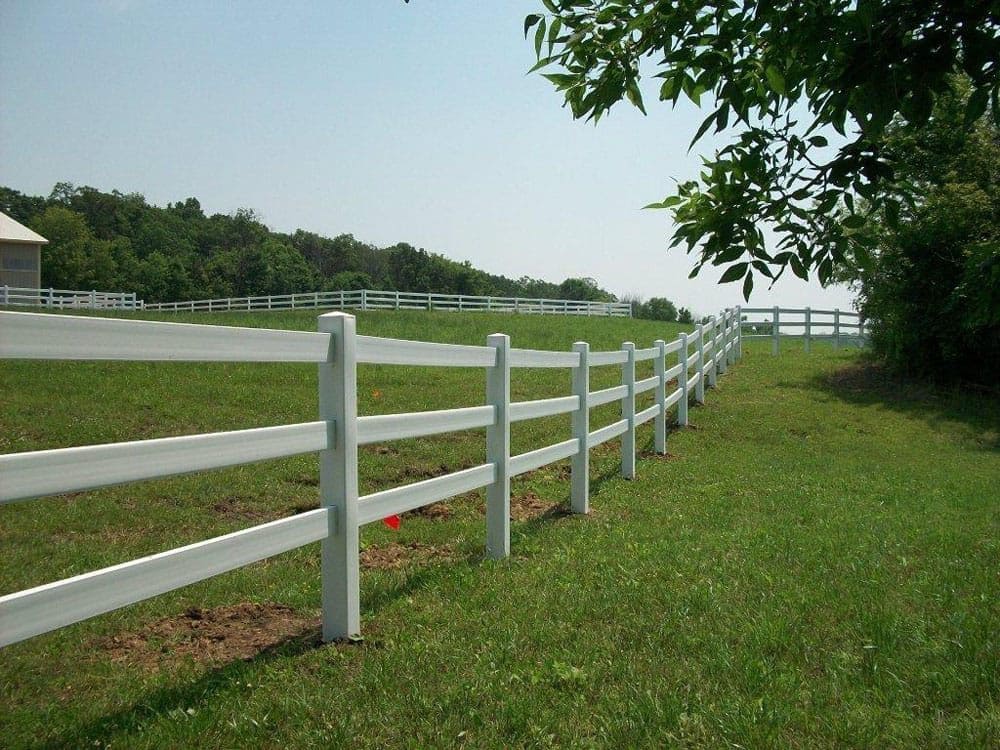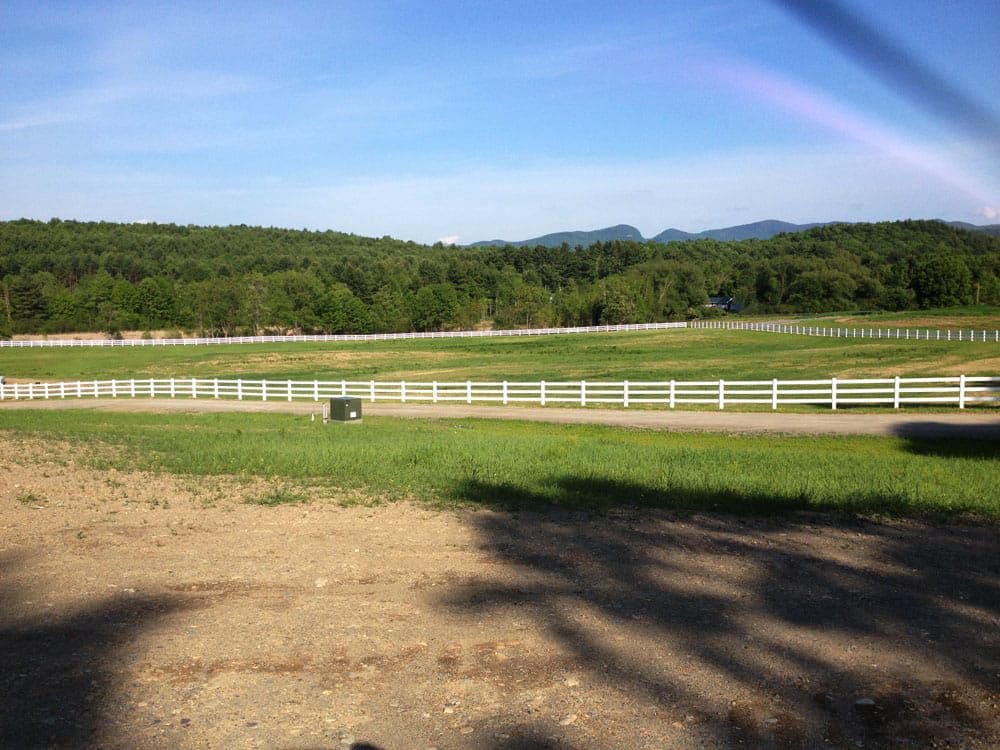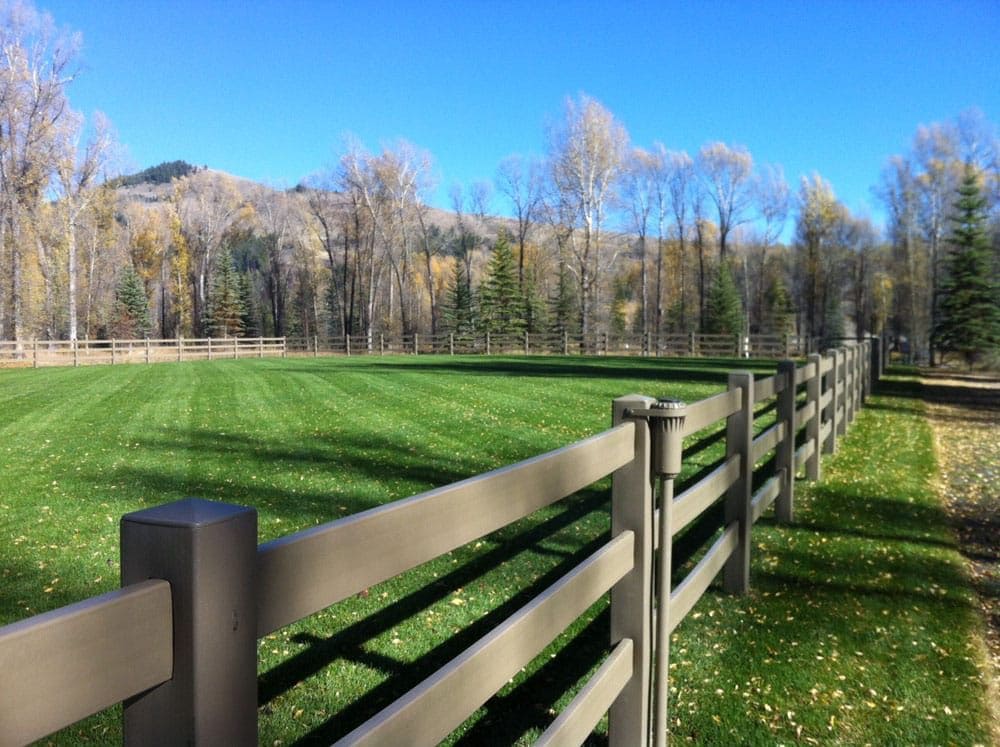Building a pasture fence is one of the most foundational improvements you can make to your property. It shapes how your animals move, how efficiently your land is used, and how much time and money you spend maintaining it.
A poorly planned fence becomes a constant source of repairs, escape attempts, sagging rails, and unexpected expenses, but a well-planned one becomes an asset that performs reliably for decades. The key is understanding each phase of the process and making informed decisions at every step.
5 Factors to Consider When Building a Pasture Fence
Before you begin digging post holes or selecting materials, it’s important to consider the foundational elements that determine how strong, safe, and functional your fence will be. These factors influence everything from durability to livestock safety, and getting them right sets the stage for a pasture fence that lasts for years to come.
1. Height
Fence height varies depending on the animals you’re containing. Horses typically require taller fencing to prevent jumping or accidental leaning, while cattle may not need the same height but require more robust materials to withstand their weight and pressure. Goats and sheep often need shorter but more escape-resistant fencing. Choosing the correct height ensures your animals stay where they belong without unnecessary risk.
2. Corner Posts
Corner posts handle the majority of structural tension in any fence line. They anchor the system, absorb pressure from wire or rails, and maintain the alignment of long runs. Because these posts take on the greatest load, they must be set deeper, installed correctly, reinforced properly, and built from materials capable of handling long-term stress. Inadequate corner posts lead to sagging lines, loose rails, and premature failure of the entire system.
3. Post Spacing
Proper post spacing affects the strength, appearance, and longevity of your fence. Spacing that’s too wide leads to sagging, while posts placed too closely waste materials and increase costs unnecessarily.
Different materials have different spacing requirements. Wire needs tighter spacing, while high-density polyethylene (HDPE) fencing often allows wider spacing due to its strength and flexibility. Additionally, terrain, animal pressure, and the type of fence all influence optimal spacing.
4. Fence Type
The type of fence you choose plays a major role in how your system performs. Wood offers a traditional look but requires ongoing maintenance. Wire is cost-effective but may pose safety risks. Vinyl provides clean aesthetics but can crack or warp over time. HDPE combines durability, flexibility, and safety, making it a standout option for long-term pasture use. Selecting the right fence type ensures the fence meets your land, livestock, and maintenance needs.
5. Gates
Gates are often the most-used and most-stressed part of any pasture fence. They must be wide enough for equipment, placed in logical locations for animal movement, and built from materials that can withstand constant opening, closing, and impact.
Gate posts require deeper installation and stronger reinforcement since they bear more movement and pressure than standard line posts. A poorly installed gate compromises the function of the entire fence.

How to Build a Pasture Fence: 6 Steps to Follow
Building a pasture fence is a structured process that blends strategy, land assessment, material selection, and careful construction. Follow these steps to build a fence that supports your animals, preserves your land, and stands strong for decades.
Step 1: Identify the Purpose of Your Fence
Every successful fencing project begins with clarity. Before you consider materials or layout, you must understand exactly what your fence needs to accomplish. The purpose defines the structure, durability requirements, height, materials, and long-term maintenance expectations.
Define the Main Purpose
A pasture fence can serve multiple roles: containing livestock, segmenting grazing areas, establishing property boundaries, or protecting crops and sensitive land. A fence built to hold horses must offer visibility and absorb impact without breaking, while a perimeter fence for cattle requires strong posts that won’t bow or push over. A fence for multi-species grazing must balance height, spacing, and safety features. By identifying the primary job of your fence, you create a roadmap for the rest of the build.
Understand Your Animals
Animals interact with fencing differently. Horses rely heavily on visibility and are prone to injury if they strike brittle materials. Cattle lean, rub, and push, meaning the fence must resist forward pressure. Goats and sheep test boundaries with climbing, squeezing, and pushing through small openings. The more you understand your animals’ behavior, the better you can select materials that prevent accidents, escapes, and long-term wear.
Evaluate Environmental Factors
Your land will determine much of your fencing strategy. Rocky soil may require specialized post installation, and clay retains moisture and can shift posts over time. Areas with deep frost lines require deeper posts to prevent heaving. Wind exposure stresses panels and rails, while heavy vegetation can press against fencing and cause sagging. Identifying these conditions now means your fence can withstand your environment year after year.
Step 2: Choose the Right Fence Type & Materials
Your material choice determines the strength, longevity, and safety of your fence. Not all materials perform well under the same conditions, especially in demanding livestock environments.
Compare Common Fencing Types
Wood is traditional but requires frequent staining and replacement due to rot, insects, and warping. Wire fencing is economical and effective for cattle or perimeter containment, but it poses injury risks and requires tension maintenance. Electric systems support training and control but can fail during outages or weather events. Vinyl offers visual appeal, but it becomes brittle over time and is prone to cracking.
HDPE fencing bridges the gap: It looks clean and polished while offering superior flexibility, strength, and weather resistance.
Evaluate Durability, Maintenance, & Cost
Consider how your fence will perform five, 10, or 20 years from now. Wood requires the most upkeep. Wire must be retensioned and repaired often. Vinyl fades and cracks under UV exposure. HDPE, however, resists environmental wear and requires little beyond occasional cleaning. When calculating cost, long-term maintenance is often more expensive than installation, so durable, low-maintenance materials are the smarter choice over time.
Consider HDPE Pasture Fencing
HDPE fencing alleviates the pitfalls of traditional materials. It doesn’t degrade, splinter, rust, or rot. Its flexibility allows it to absorb heavy impacts without breaking. It’s UV-stabilized, meaning sunlight won’t cause it to fade or weaken. And because HDPE lasts for decades with minimal upkeep, it provides one of the best long-term returns of any fencing system.
Step 3: Plan the Fence Line
Planning your fence line is an important part of creating a framework that supports long-term durability, ease of use, and efficient land management. A well-planned fence line minimizes material waste, prevents premature sagging, improves drainage performance around posts, and ensures your fencing system works with your land rather than against it. If you thoroughly plan the route of your fence, you’ll encounter fewer surprises during installation.
Map & Mark the Layout
Begin by walking your land with a careful, observant eye. Take note of slopes, high-traffic animal paths, washout areas, tree lines, and access points for equipment. Use stakes, spray paint, or flags to mark every corner, straight run, and potential curve. Doing this preparation now avoids the frustration of discovering a poorly placed gate or difficult terrain after installation has already begun.
This process helps you visualize the fence in full and allows you to adjust the layout before digging holes. Mapping also reveals where you may need reinforced posts, slight directional changes, or adjusted spacing.
Determine Layout Details
Once the basic route is mapped, begin determining the structural details of the fence. Identify the ideal height for your livestock—higher for horses, lower for goats or sheep. Consider how close your posts need to be based on the material you’ve selected. For example, HDPE systems often allow for wider spacing, while wire may require closer placements.
Additionally, evaluate whether the fence line should be perfectly straight or if slight curves will help it better follow the natural landscape. Thoughtful measurements and precise spacing at this stage lead to cleaner installation and a longer-lasting fence.
Check Local Requirements
Local zoning rules and agricultural regulations may dictate how your fence can be built, including height limits, set-back distances, and acceptable materials. Verifying your exact property boundaries also helps prevent disputes with neighbors and maintain legal compliance.
Taking the time to handle permits, boundary verification, and zoning reviews now protects you from costly corrections later.
Step 4: Prepare the Pasture
Preparation is the physical foundation of your fencing system. Even the strongest materials won’t perform well if installed on unstable, cluttered, or poorly prepared ground. Thorough preparation improves installation efficiency and prevents alignment shifts over time.
Clear the Fence Line
A proper fence line must be completely free of debris, brush, and obstructions. Removing fallen limbs, overgrown weeds, and low-hanging branches keeps anything from rubbing against or falling onto your fence during installation. Stumps and roots can interfere with post placement, while thick brush may trap moisture that accelerates deterioration in certain materials.
By creating a clean, level corridor for your fence, you make sure it stands straight and remains accessible for routine inspections and maintenance.
Assess Ground Conditions
Understanding your soil conditions is critical for stable, long-lasting posts. Sandy soils may require deeper holes or additional stabilizing material, while clay soils hold moisture and expand seasonally, potentially shifting posts unless reinforced properly. Uneven terrain may need grading to maintain a consistent fence height and reduce strain on rails or wire.
Always locate underground utilities before digging. Besides being a safety necessity, it prevents costly disruptions and is a law in some cities and states. Identifying drainage paths is equally important; standing water weakens many fence types over time and may necessitate gravel backfill or drainage adjustments.
Gather Tools & Materials
Before installation begins, organize your materials and equipment, including augers, digging bars, fork lifts, levels, string lines, post drivers, rails, posts, fasteners, and gates. When all tools and materials are staged near the fence line, installation proceeds more efficiently and with fewer interruptions.
Step 5: Install the Fence
Installation is where planning meets execution. Taking the time to install each component correctly ensures the fence performs well under livestock pressure and environmental stresses. Alternatively, rushing installation often leads to uneven lines, leaning posts, or rails that pop loose under strain.
Set the Posts
The integrity of your entire fence depends on properly installed posts. Dig holes to an appropriate depth, typically one-third of the post’s total length or deep enough to reach stable soil below the frost line. Set posts in gravel or concrete depending on your soil type and fence material. Corners, ends, and gate posts should be reinforced as they withstand the highest levels of tension and pressure.
Install Rails or Wire
After your posts are firmly set and aligned, you can begin attaching rails, panels, or wire as needed for the fence type you chose. Rails must be fully seated in their designated openings and secured tightly to avoid rattling or shifting. Wire systems must be tensioned evenly to prevent sagging or snapping under pressure.
The goal is a fence line that appears clean, straight, and consistent. HDPE rails offer an advantage here, as their impact absorption and flexibility reduce the risk of animal injuries while maintaining alignment and appearance.
Install Gates
Gates require extra attention because they endure far more movement and force than any other section of your fence. Choose gates designed for agricultural use and install them at least wide enough to accommodate livestock, tractors, and equipment. Gate posts should be set deeper than line posts and reinforced to prevent leaning. Install hinges, latches, and braces carefully to ensure smooth operation.
Step 6: Implement Safety & Maintenance Practices
A well-built fence still requires routine care to remain safe and functional. By creating a consistent inspection schedule and performing quick maintenance tasks, you extend the life of your fence and reduce the risk of animal injury or escape.
Livestock Safety
Animals constantly interact with fences, whether through leaning, rubbing, scratching, or accidental impact. Safety-focused materials and regular inspections help prevent accidents.
Walk the entire fence line every few weeks and after major weather events. Look for broken rails, exposed screws, loose wires, or leaning posts. Prioritize visibility, as livestock, especially horses, must clearly see the boundaries. HDPE excels here because its bold color and solid profile stand out against natural environments.
Maintenance by Material
Different materials age in different ways. Wood must be monitored for splintering, fungal growth, rot, and insect damage and may require repainting or staining. Wire fences need tension adjustments and repair of sagging or snapped sections. Vinyl can become brittle and crack with age or temperature fluctuations. HDPE requires minimal maintenance; an occasional wash, a quick inspection of hardware, and periodic tightening of connectors is usually all it needs.
Seasonal Checks
Each season introduces new challenges. Winter frost may shift posts, heavy snow can weigh down rails, summer heat can strain traditional materials, and storms may drop debris across fence lines. Conduct seasonal inspections focused on environmental stress points. Addressing these early prevents cumulative damage.
Fortunately, HDPE’s all-weather durability reduces the severity and frequency of seasonal issues, making it particularly well suited for demanding climates.

Why Choose HDPE Fencing for Your Pasture?
Selecting the right fencing system determines how your fence performs over the next 20–30 years. Derby Fence’s HDPE systems stand out by addressing the biggest pain points landowners face: durability, safety, environmental impact, maintenance, and appearance.
Built for Maximum Durability
Our HDPE rails and posts are engineered to withstand extreme temperatures, impacts from livestock, and constant environmental stress. Unlike wood, HDPE will not rot, mold, splinter, or host insects. Unlike vinyl, it will not crack under pressure or cold weather. Unlike metal, it will not rust. Its strength and flexibility help it resist forces that would break other materials.
Designed for Livestock Safety
HDPE flexes on impact, absorbing force rather than shattering—a critical advantage for horses that may collide with fencing. Smooth surfaces and rounded edges prevent lacerations and punctures. Additionally, the material’s consistent color and visibility help animals recognize boundaries, reducing accidents and fence-related injuries.
Sustainable & Eco-Friendly
HDPE fencing is made from recyclable materials and lasts significantly longer than traditional fencing, which reduces landfill waste and the environmental cost of repeated replacements. We use environmentally responsible manufacturing methods to offer a solution that aligns with land stewardship values.
Cost Effective Over Its Lifetime
While the upfront investment may be higher than some materials, HDPE eliminates most long-term costs. There is no need for painting, staining, pest treatment, or rail replacement. Its longevity means fewer installations over the lifespan of your property, making HDPE pasture fencing one of the most economical choices for serious landowners.
Consistent, Attractive Appearance
HDPE maintains its appearance for decades without fading, chipping, or peeling. It does not require refinishing or painting. The uniform color creates a clean, polished look that improves curb appeal and boosts property value.
FAQs About Building a Pasture Fence
How Tall Should a Pasture Fence Be?
The ideal height depends on the type of livestock. Horses generally require fences between 54 and 60 inches to prevent jumping or accidental contact. Cattle often do well with fences around 48 inches, while goats and sheep may require shorter but more escape-resistant designs. Always choose a height that aligns with the behavior and size of the animals you’re containing.
What’s the Most Durable Type of Pasture Fencing?
HDPE fencing is one of the most durable modern pasture fencing options because it resists rot, rust, splintering, UV damage, and weather-related stress. Traditional wood and vinyl deteriorate much faster, and wire systems require frequent tensioning. HDPE offers long-term performance with minimal maintenance.
How Far Apart Should Fence Posts Be?
Post spacing typically ranges from six to 12 feet depending on the fence type, terrain, and livestock. Wire fences often require closer spacing to maintain tension, while HDPE systems can allow wider spacing due to their structural strength. Proper spacing prevents sagging, bowing, and premature rail or wire failure.
How Many Gates Should a Pasture Fence Have?
Most pastures should have at least one gate large enough for equipment access, but multiple gates can improve movement flow for animals and simplify maintenance. Place gates near pathways, corners, and areas frequently used for feeding, loading, or moving livestock.
Do Corner Posts Really Matter That Much?
Yes. Corner posts bear the most stress and tension in any fencing system. If corner posts fail, the entire fence line begins to sag and lose structural integrity. Reinforcing corner posts with deeper footings or bracing helps maintain lasting strength.
Find the Best Pasture Fencing Options at Derby Fence
A dependable pasture fence starts with thoughtful planning, detailed preparation, and the right materials. Each step in the process, from assessing your land to reinforcing your posts, contributes to a structure built for longevity and safety.
If you want a pasture fence that delivers lifelong durability, exceptional safety for your livestock, and the lowest total ownership cost, Derby Fence’s HDPE fencing systems stand above the competition. Their engineered materials, proven performance, and minimal maintenance requirements make them the ideal solution for landowners who expect decades of reliability.
Ready to upgrade your pasture fencing? Contact Derby Fence today for a free quote and personalized fencing consultation. Our team is here to help you create a safe, beautiful, and efficient equestrian environment with the highest-quality HDPE pasture fencing on the market.


